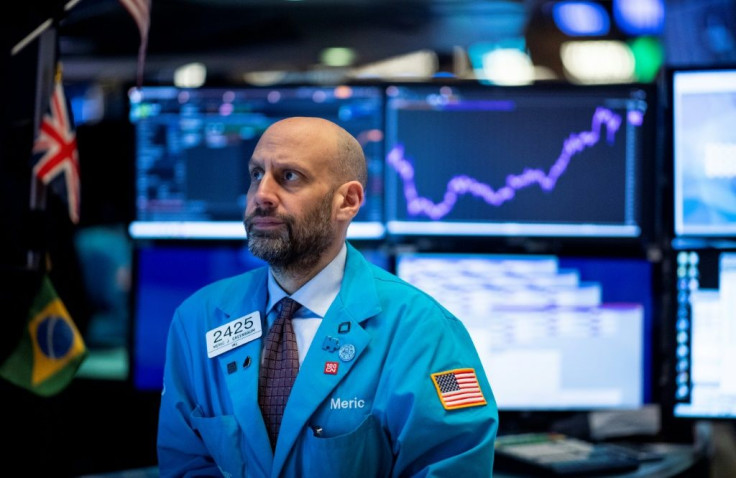Tuesday's Stock Market Open: US Equities Bounce Back From Monday’s Massive Losses

KEY POINTS
- Coronavirus cases in China now approaching 80,000.
- Iran has the most virus-related deaths outside of China with 15
- South Korea now has almost 1,000 virus infections
Update: 2:50 p.m. EST:
Tuesday’s stock sell-off continued unabated in late afternoon trading.
The Dow Jones Industrial Average plunged 802.15 points to 27,158.65 while the S&P 500 dropped 85.35 points to 3,140.54 and the Nasdaq Composite Index fell 215.47 points to 9,005.81.
Update: 1:10 p.m. EST:
Tuesday’s stock sell-off deepened in early afternoon trading.
The Dow Jones Industrial Average dropped 537.94 points to 27,422.86 while the S&P 500 dropped 59.68 points to 3,166.21 and the Nasdaq Composite Index fell 151.43 points to 9,069.85.
Update: 12:05 p.m. EST:
U.S. stocks incurred losses by noon on Tuesday as an early morning attempt at a rebound from Monday’s huge drop ran out of steam.
The Dow Jones Industrial Average dropped 264.9 points to 27,695.90 while the S&P 500 dropped 28.51 points to 3,197.38 and the Nasdaq Composite Index fell 61.2 points to 9,160.08.
The Conference Board’s consumer confidence index came in at 130.7 for February, up from 130.4 in January, but below economists’ expectations of a 132.6 reading.
U.S. house prices rose 5.1% in the fourth quarter of 2019 on a year-over-year basis, reported the Federal Housing Finance Agency.
In Europe markets finished broadly lower, as Britain’s FTSE-100 fell 1.94%, France’s CAC-40 tumbled 1.94% and Germany’s DAX dropped 1.88%.
Update: 11:10 p.m. EST:
U.S. stocks continued to deepen losses in late-morning trade.
The Dow Jones Industrial Average dropped 272.92 points to 27,687.88 while the S&P 500 dropped 32.51 points to 3,193.38 and the Nasdaq Composite Index fell 102.46 points to 9,118.82.
Major European stock indexes have incurred losses of about 1.9%
Update: 10:40 p.m. EST:
Stocks have turned lower in mid-morning trade as an earlier attempt at a recovery from Monday’s steep losses failed.
The Dow Jones Industrial Average dropped 148.62 points to 27,812.18 while the S&P 500 fell 21.06 points to 3,204.83 and the Nasdaq Composite Index tumbled 57.77 points to 9,163.51.
In Europe markets were also lower, as Britain’s FTSE-100 fell 1.43%, France’s CAC-40 tumbled 1.42% and Germany’s DAX dropped 1.27%.
Original story:
U.S. stocks opened higher on Tuesday as markets rebounded from Monday’s losses. However, traders remained worried over the coronavirus outbreak that has now reached the Middle East and Europe.
The Dow Jones Industrial Average gained 179.88 points to 28,140.68 while the S&P 500 gained 20.39 points to 3,246.28 and the Nasdaq Composite Index rise 92.01 points to 9,313.29.
China’s National Health Commission reported 77,658 confirmed cases of coronavirus as of Tuesday, with 2,663 deaths.
U.S. President Donald Trump said Beijing was “getting [the virus outbreak] under control more and more.”
South Korea confirmed 84 more cases of the coronavirus, raising the total number of infections to 977 in the country.
Iran reported 95 people infected with the coronavirus, with 16 deaths nationwide, the highest death toll outside of China. Several nations have banned travel to and from Iran.
The Trump administration requested $2.5 billion from Congress to fight coronavirus.
China said it will release from clinical trials of a Gilead Sciences (GILD) drug in April as a virus treatment
Oxford Economics estimated the virus epidemic may wipe out more than $1 trillion from global domestic product.
Mastercard (MA) and United Air Lines (UAL) warned that the virus in China will hurt their sales and profits.
“The market is flying blind with this virus and how things play out from here,” said Peter Boockvar, chief investment office at Bleakley Financial Group. “The only two certainties is that the current economic impact is profound globally and that the virus will eventually go away and things will bounce back. What happens in between is impossible to say.”
“The huge jump [in virus outbreaks] over the weekend to various other countries has many reassessing 2020 growth estimates,” said Ryan Detrick, senior market strategist for LPL Financial. “We could see quickly decreasing earnings and growth outlooks.”
In December, home prices climbed by 3.8% on the S&P CoreLogic Case-Shiller National Home Price Index, versus 3.5% gain in November.
“The U.S. housing market continued its trend of stable growth in December,” said Craig J. Lazzara, managing director and Global Head of Index Investment Strategy at S&P Dow Jones Indices. “This marks eight consecutive years of increasing housing. At the national level, home prices are 59% above the trough reached in February 2012, and 15% above their pre-financial crisis peak. Results for 2019 were broad-based, with gains in every city in our 20-City Composite.”
Overnight in Asia, markets finished mixed. China’s Shanghai Composite slipped 0.6%, while Hong Kong’s Hang Seng edged up 0.27%, and Japan’s Nikkei-225 fell 3.34%.
In Europe markets were lower, as Britain’s FTSE-100 fell 0.79%, France’s CAC-40 tumbled 0.67% and Germany’s DAX dropped 0.39%.
Crude oil futures edged down 0.08% at $51.39 per barrel and Brent crude slipped 0.34% at $55.58. Gold futures skidded 1.51%.
The euro fell 0.11% at $1.0843 while the pound sterling gained 0.43% at $1.2986.
© Copyright IBTimes 2024. All rights reserved.





















